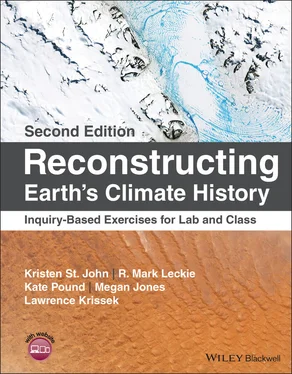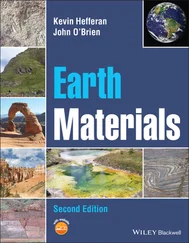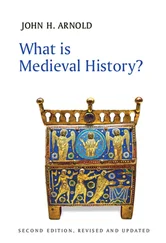Kristen St. John - Reconstructing Earth's Climate History
Здесь есть возможность читать онлайн «Kristen St. John - Reconstructing Earth's Climate History» — ознакомительный отрывок электронной книги совершенно бесплатно, а после прочтения отрывка купить полную версию. В некоторых случаях можно слушать аудио, скачать через торрент в формате fb2 и присутствует краткое содержание. Жанр: unrecognised, на английском языке. Описание произведения, (предисловие) а так же отзывы посетителей доступны на портале библиотеки ЛибКат.
- Название:Reconstructing Earth's Climate History
- Автор:
- Жанр:
- Год:неизвестен
- ISBN:нет данных
- Рейтинг книги:3 / 5. Голосов: 1
-
Избранное:Добавить в избранное
- Отзывы:
-
Ваша оценка:
- 60
- 1
- 2
- 3
- 4
- 5
Reconstructing Earth's Climate History: краткое содержание, описание и аннотация
Предлагаем к чтению аннотацию, описание, краткое содержание или предисловие (зависит от того, что написал сам автор книги «Reconstructing Earth's Climate History»). Если вы не нашли необходимую информацию о книге — напишите в комментариях, мы постараемся отыскать её.
how we know
what we know
Reconstructing Earth’s Climate History, Second Edition,
Reconstructing Earth's Climate History — читать онлайн ознакомительный отрывок
Ниже представлен текст книги, разбитый по страницам. Система сохранения места последней прочитанной страницы, позволяет с удобством читать онлайн бесплатно книгу «Reconstructing Earth's Climate History», без необходимости каждый раз заново искать на чём Вы остановились. Поставьте закладку, и сможете в любой момент перейти на страницу, на которой закончили чтение.
Интервал:
Закладка:
Table of Contents
1 Cover
2 Title Page
3 Copyright Page
4 The Authors
5 Foreword from First Edition
6 Acknowledgments
7 Book Introduction to the Second Edition for Students and Instructors Motivation and Purpose Use of Real Data Content Topics Transportable Skills Practical Use of Multipart Exercises Audience Classroom Tested
8 About the Companion Website
9 Chapter 1: Introduction to Paleoclimate Records Part 1.1. Archives and Proxies Part 1.2. Obtaining Cores from Terrestrial and Marine Paleoclimate Archives Part 1.3. Owens Lake – An Introductory Case Study of Paleoclimate Reconstruction References
10 Chapter 2: Seafloor Sediments Part 2.1. Sediment Predictions Part 2.2. Core Observation and Description Part 2.3. Sediment Composition Part 2.4. Seafloor Sediment Synthesis References
11 Chapter 3: Geologic Time and Geochronology Part 3.1. The Geologic Timescale Part 3.2. Principles of Stratigraphy and Determining Relative Ages Part 3.3. Radiometric Age Dating Fundamentals Part 3.4. Using 40K – 40Ar Dating to Determine the Numerical Ages of Layered Volcanic Rocks Part 3.5. Using Uranium Series Dating to Determine Changes in Growth Rate of Speleothems References
12 Chapter 4: Paleomagnetism and Magnetostratigraphy Part 4.1. Earth's Magnetic Field Today and the Paleomagnetic Record of Deep‐Sea Sediments Part 4.2. History of Discovery: Paleomagnetism in Ocean Crust and Marine Sediments Part 4.3. Using Paleomagnetism to Test the Seafloor Spreading Hypothesis Part 4.4. The Geomagnetic Polarity Timescale References
13 Chapter 5: Microfossils and Biostratigraphy Part 5.1. What Are Microfossils? Why Are They Important in Climate Change Science? Part 5.2. Microfossils in Deep‐Sea Sediments Part 5.3. Application of Microfossil First and Last Occurrences Part 5.4. Using Microfossil Datums to Calculate Sedimentation Rates Part 5.5. How Reliable Are Microfossil Datums? Part 5.6. Organic‐Walled Microfossils: Marine Dinoflagellates and Terrestrial Pollen and Spores References
14 Chapter 6: CO 2as a Climate Regulator During the Phanerozoic and Today Part 6.1. The Short‐Term Global Carbon Cycle Part 6.2. CO 2and Temperature Part 6.4. The Long‐Term Global Carbon Cycle, CO 2, and Phanerozoic Climate History Part 6.5. Carbon Isotopes as a Tool for Tracking Changes in the Carbon Cycle References
15 Chapter 7: Oxygen Isotopes as Proxies of Climate Change Part 7.1. Introduction to Oxygen Isotope Records from Ice and Ocean Sediments Part 7.2. The Hydrologic Cycle and Isotopic Fractionation Part 7.3. δ 18O in Meteoric Water and Glacial Ice Part 7.4. δ 18O in Marine Sediments References
16 Chapter 8: Climate Cycles Part 8.1. Patterns and Periodicities Part 8.2. Orbital Metronome Part 8.3. Glacial–Interglacial Periods and Modern Climate Change References
17 Chapter 9: The Paleocene–Eocene Thermal Maximum (PETM) Event Part 9.1. An Important Discovery Part 9.2. Global Consequences of the PETM Part 9.3. Two Hypotheses for the Cause of the PETM Part 9.4. Rates of Onset and Duration of Event Part 9.5. Global Warming Today and Lessons from the PETM References
18 Chapter 10: Glaciation of Antarctica Part 10.1. Initial Evidence Part 10.2. Evidence for Global Change Part 10.3. Mountain Building, Weathering, CO 2and Climate Part 10.4. Legacy of the Oi1 Event: The Development of the Psychrosphere References
19 Chapter 11: Antarctic Climate Variability in the Neogene Part 11.1. What Do We Think We Know About the History of Antarctic Climate? Part 11.2. What is Antarctica's Geographic and Geologic Context? Part 11.3. Selecting Drillsites to Best Answer our Questions Part 11.4. What Sediment Facies are Common on the Antarctic Margin? Part 11.5. The BIG Picture of ANDRILL 1‐B References
20 Chapter 12: Pliocene Warmth as an Analog for Our Future Part 12.1. The Last 5 Million Years Part 12.2. Pliocene Latitudinal Temperature Gradient Part 12.3. Estimates of Pliocene CO 2 Part 12.4. Sea Level Past, Present, and Future References
21 Chapter 13: Climate, Climate Change, and Life Part 13.1. Initial Ideas Part 13.2. The Long View: “Precambrian” and Phanerozoic Life and Climate Part 13.3. Examples of Cenozoic Terrestrial Evolution and Climate Connections Part 13.4. Examples of Cenozoic Marine Biotic Evolution and Climate Connections Part 13.5. Humanity, Climate, and Life Part 13.6. Humanity and Future Climate: At a Tipping Point References
22 Chapter 14: Climate Change and Civilization Part 14.1. Climate Change Here and Now Part 14.2. Evidence of Climatic Stress on Ancient Maya Civilization Part 14.3. The Precipitation Record of the North American Southwest: The Physical Record and Human Response References
23 Index
24 End User License Agreement
List of Tables
1 Book Introduction to the Second Edition for Students and Instructors TABLE 1. Chapter alignment to scientific content, skills, and USGCRP (2009) c...
2 Chapter 1 TABLE 1.1. Selected major paleoclimate archives and the proxy data they conta...
3 Chapter 2 TABLE 2.1. Seafloor cores. TABLE 2.2. Smear slide composition and textural data, plus presence/absence o...
4 Chapter 3 TABLE 3.1. A simple example of the changes in the numbers of atoms of the par... TABLE 3.2. 40Ar/ 40K results for five samples of basalt from Jokuldalur, Iceland (...TABLE 3.3. 230Th/ 234U activity ratios as a function of depth in speleothem BTVC4 ...TABLE 3.4. Corrected ages as a function of depth in speleothem BTVC4 from Cav...
5 Chapter 4TABLE 4.1. Estimates for the age of ocean crust (basement) and the age of the...
6 Chapter 5TABLE 5.1. The table displays rows of samplesand the depth of those samples i...TABLE 5.2. The table displays rows of samplesand the depth of those samples i...TABLE 5.3. Calcareous nannofossil datums, ages, and depths from Hole 1208A.TABLE 5.4. Calcareous nannofossil datums, ages, and depths from Hole 1208A Sh...TABLE 5.5. Calcareous nannofossil datums, ages, and depths from Hole 999 in t...
7 Chapter 6TABLE 6.1. The four most abundant greenhouse gases.TABLE 6.2. Earth system feedback factors.
8 Chapter 8TABLE 8.1. Data summary.
9 Chapter 9TABLE 9.1. Synthesis of observations for PETM.TABLE 9.2. Published estimates for the time interval, carbon accumulation, and...
10 Chapter 10TABLE 10.1. Paleoecologic preferences of the species or genera of calcareous n...TABLE 10.2. Synthesis of observations.
11 Chapter 11TABLE 11.1. General interpretation of Oligocene–Holocene Antarctic climate, as...
12 Chapter 12TABLE 12.1. Estimated potential maximum sea level risefrom the total melting ...TABLE 12.2. Elevations of major coastal cities in the U.S. (based on major ai...
13 Chapter 14TABLE 14.1. Vulnerability factors and their indicators (Chen et al. 2015).TABLE 14.2. Readiness factors and their indicators (Chen et al. 2015).
List of Illustrations
1 Chapter 1 FIGURE 1.1. Cross sections (a view perpendicular to growth or accumulation) ... FIGURE 1.2. Terrestrial and marine depositional environments, and example se... FIGURE 1.3. Three paleoclimate archives. (a) A sedimentary outcropfrom Bast... FIGURE 1.4. (a) Global geographic distribution of lake and ocean core sites.... FIGURE 1.5. Example of (left) an ice core from Huascaran, Peru, and (right) ... FIGURE 1.6. Piece of an Antarctic ice core showing trapped air bubbles. FIGURE 1.7. Class 100 Clean Room at Byrd Polar and Climate Research Center. ... FIGURE 1.8. Scientific research vessel, JOIDES Resolution . FIGURE 1.9. Scientific ocean drilling site locations of the International Oc... FIGURE 1.10. Example of coring and core terminology (from ODP Leg [i.e. Expe... FIGURE 1.11. Photo of the archive‐half of Core 2 from Hole 1215A, located in...
Читать дальшеИнтервал:
Закладка:
Похожие книги на «Reconstructing Earth's Climate History»
Представляем Вашему вниманию похожие книги на «Reconstructing Earth's Climate History» списком для выбора. Мы отобрали схожую по названию и смыслу литературу в надежде предоставить читателям больше вариантов отыскать новые, интересные, ещё непрочитанные произведения.
Обсуждение, отзывы о книге «Reconstructing Earth's Climate History» и просто собственные мнения читателей. Оставьте ваши комментарии, напишите, что Вы думаете о произведении, его смысле или главных героях. Укажите что конкретно понравилось, а что нет, и почему Вы так считаете.



